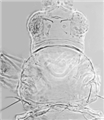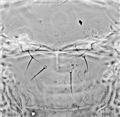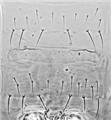Trichromothrips cyperaceae
Recognition data
Distinguishing features
Female fully winged. Body yellow, abdominal apex and distal antennal segments light brown; forewings pale. Head wider than long; two pairs of ocellar setae, pair III longer than width of eye; one small tubercle on inter-antennal projection; ocellar region with no sculpture, vertex with a few transverse lines. Antennae 8-segmented; segment I with paired small setae on dorsal apex; segments III � IV with small slender forked sensorium. Pronotum without sculpture; two pairs of long posteroangular setae, two pairs of posteromarginal setae. Metanotum without sculpture; median setae far back from anterior margin; no campaniform sensilla. Forewing first vein with two setae on distal half; second vein with about 12 setae. Abdominal tergites with weak sculpture lines laterally; tergite VIII with no marginal comb; tergite X with no longitudinal split. Sternites III � VII with six to twelve discal setae.
Related and similar species
The genus Trichromothrips includes worldwide a total of 31 species (Masumoto & Okajima, 2005), and this includes species that at one time were placed in the genus Dorcadothrips. A second species recorded from California, T. xanthius (Williams), can be distinguished by the presence laterally on abdominal sternites V � VI of paired dark, coarsely-grained areas of sculpture. T. xanthius is apparently associated with orchids (Bhatti, 2000).
Taxonomic data
Current valid name
Trichromothrips cyperaceae (Bianchi)
Original name and synonyms
Taeniothrips cyperaceae Bianchi, 1945: 283
Family placement
Thripidae, Thripinae
Biological data
Life history
No information
Host plants
Cyperus rotundus (Cyperaceae) (Bhatti, 2000).
Tospoviruses vectored
None
Crop damage
None
Distribution data
Area of origin
Not known
Distribution
Bermuda, California, Hawaii




